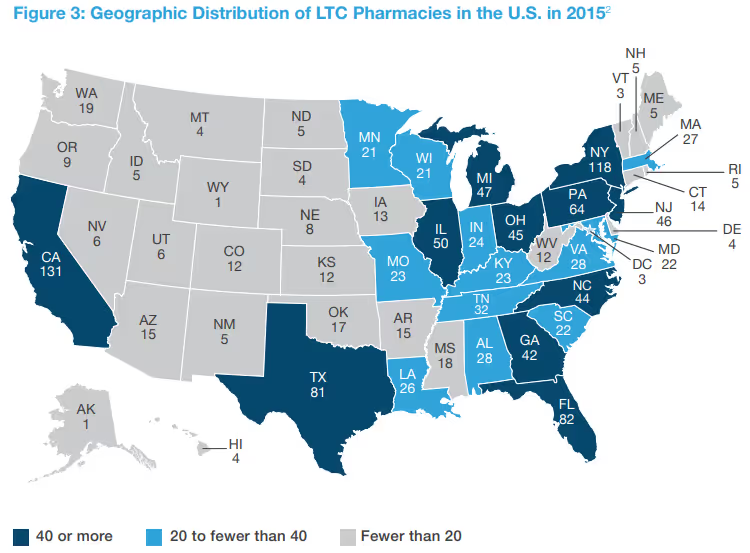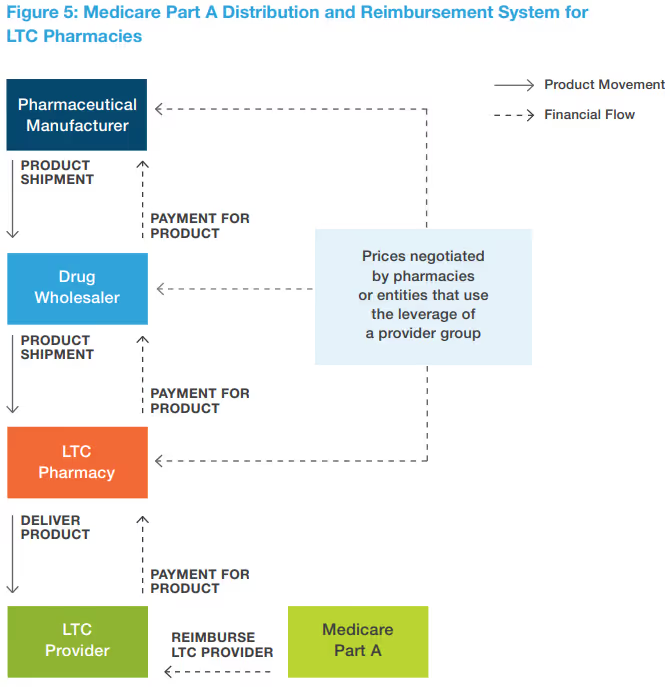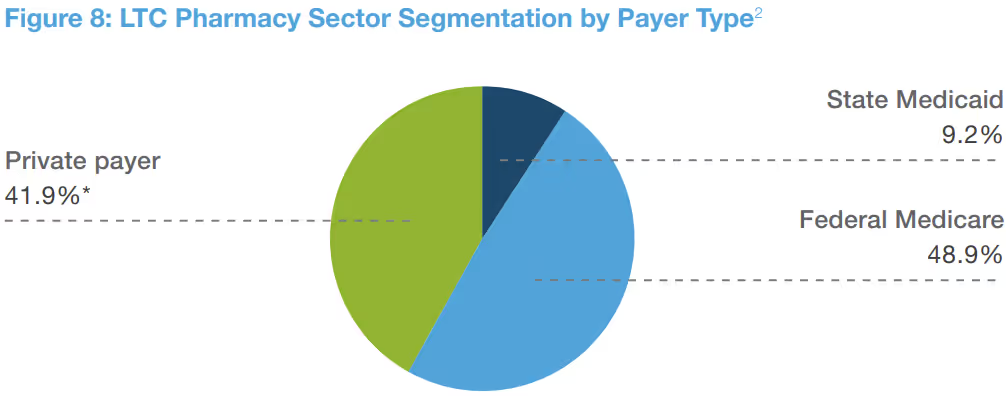Long-Term Care Pharmacy Billing: An Ultimate Guide
Using the right strategy and technology is the key to properly managing this space. Let’s take a look at what exactly LTC pharmacy entails and how to ensure accuracy when handling its data.

In the United States, there are over 26,500 nursing homes. These long-term care (LTC) facilities serve about 1.4 million residents, each of which has its own diagnoses, treatment plans, and prescriptions.
So you can imagine that the prescription billing for these facilities can be quite complex.
Different from retail pharmacies, LTC pharmacies face a very specific set of billing challenges and intricacies that can affect the efficiency of their operation.
Dealing with these nuances can cost your organization time and money. Such issues may include navigating billing models, payer requirements, and complicated Medicare guidelines. With that said, there is a way to effectively manage the complexities of LTC billing.
Using the right strategy and technology is the key to properly managing this space. Let’s take a look at what exactly LTC pharmacy entails and how to ensure accuracy when handling its data.
What is Long-Term Care?
Long-term care is any service that includes medical and non-medical care, provided to those who are unable to perform basic activities. These activities can include things such as dressing and bathing. There are a wide variety of support services that fall under the LTC category.

Those that can benefit from LTC services include:
- Patients with complex medical needs. Those patients who require 24-hour care or monitoring to maintain wellness.
- Patients recovering from serious medical events. This includes heart attack, stroke, or cardiac surgeries.
- Patients recovering from injuries/procedures.
- Patients who live with either temporary or long-term conditions that inhibit mobility.
- Patients who have physical impairments. These interfere with basic activities such as bathing, dressing, or using the toilet.
- Patients who need assistance with managing household tasks. Such as food preparation, cleaning, paying bills, and managing medications.
- Patients with Alzheimer’s disease or other cognitive issues.
The financing of LTC services comes from a variety of public and private sources. State Medicaid and Medicare Part D plans make up the primary payers. Other payers include contracts with nursing homes for patients covered under Medicare Part A and private insurers.
One of the most important services to consider when evaluating a long-term care facility is what pharmacy they work with.
What is an LTC Pharmacy?
An LTC pharmacy provides specialized medication services/management for long-term care patients. These services are crucial for ensuring the accuracy and efficiency of medication administration to facility residents.
Services can include:
- Daily delivery of medications in secure medication carts.
- Unit-dose packaging.
- Medication administration records (MARs).
- Medication synchronization.
- Prevent the diversion of controlled substances stored in the facility.

The LTC pharmacy ensures that medications get dispensed via medication carts, sectioned into separate compartments for each resident.
Each cart contains tools to assist in:
- Medication administration.
- Medication storage.
- Providing security of medications.
- Documentation of medication received, taken, refill requests, and discontinuations.
LTC pharmacies aim to streamline the medication management process with the use of these carts. Improving accuracy and enhancing patient safety while keeping data orderly and organized.
These pharmacies also provide facilities with medication emergency starter kits. Facilities use these kits to meet the immediate needs of patients in accordance with their prescriber’s order.
Please note that LTC facilities don’t usually own these pharmacies, but work with them through a contracted business relationship. LTC pharmacies are likely to hold contracts with a variety of different residential facilities.
Now that you know what a long-term care pharmacy is, let’s go over the best ways to prevent otherwise avoidable long-term care pharmacy billing errors.
How to Make Sure Your LTC Pharmacy Billing Workflow Runs Smoothly
Invest in LTC Pharmacy Software
Not all software management systems are alike. There’s management software specifically designed to resolve the billing complexities of the LTC pharmacy space. Investing in the proper LTC billing software will help better streamline your workflow and avoid wasted time and money.
Utilizing retail pharmacy management software as an LTC pharmacy can leave you reaping less than desirable results. The wrong management software in this case might be ill-equipped to handle specific scenarios that appear in LTC. Examples of these specific scenarios could be changes to billing preferences and payer statuses.
Also, retail pharmacies typically fill and bill for prescriptions as they’re dispensed. LTC pharmacies need software that allows for them to fill at different times than the bill. Being able to prepare billing cycles in advance and to separate the billing and filling functions are software features all LTC pharmacies should look for.

The software solution should also be able to support a multitude of billing models used in LTC, such as:
- Medicare Part A Billing - Covers care at a skilled nursing facility after a hospital discharge.
- Medicare Part B Billing - Covers durable medical equipment (DME) when your doctor or another healthcare provider prescribes it.
- Medicare Part D Billing - This is an optional prescription drug program. Medicare Part D helps cover the cost of prescribed medications.
- Hospice Billing - End-of-life medication billing. Sent to a hospice care plan.
- Per Diem Billing - Follows a previously agreed-upon daily rate for services. This includes medications and is with or without exclusions.
- Split Billing - When you bill a single dispensing of medication to multiple payers. This is due to a change in payer status.
- Short Cycle Billing - This allows the pharmacy to dispense medications in shorter increments. Patients may prefer their refills in 7 or 14-day supply as opposed to 30 days.
- Pre/Post-Consumption Billing - Separates the adjudication and dispensing functions. Combines multiple files into one claim.
Correct Billing Setup Structure
Similar to making sure you utilize the correct billing software, ensure your billing structure is set up to support your LTC pharmacy needs. Your staff will thank you!
Having your billing workflow and technology set up correctly will:
- Reduce unnecessary human errors.
- Avoid potential data entry pitfalls.
- Improve your billing accuracy as a whole.
For LTC-designed billing solutions, customization is available to ensure a patient’s payer status is appropriate for a certain period of time. This is helpful because most patients who seek care from an LTC facility are likely to use multiple billing models during their stay.

Depending on their coverage and treatment needs, a patient might have plans including:
- Medicare Part A.
- Medicare Part B.
- Medicare Part D.
- Commercial insurance.
- Hospice.
- Private pay.
It’s important to be able to set up your patient’s billing structure in terms of how those plans can trickle down from one to another. This way, your data entry technician doesn't need to waste time fixing the structure, but instead just needs to focus on correctly entering data.
During data entry, your system should look at:
- Type of medication.
- The dates a patient is in the facility.
- Payment plan to bypass plans when they're not needed. An example might be a plan for over-the-counter medications that aren’t covered.
Implement Software Training
Arguably, the most effective way to avoid errors and complexities comes from training. This is true for most workplace systems. Long-term care pharmacies must complete training through their respective pharmacy software vendor. This is in order to effectively deter billing complexities unique to LTC.
Having a well-trained customer service/support team will help maximize your organization’s workflow. When setting up this training process, we recommend you:
- Complete an in-depth review of your existing workflows and infrastructure.
- Rework existing data into your comprehensive training.
Conclusion
As an LTC pharmacy organization, you are an essential provider for the aging population. Therefore, you cannot afford consistent errors. According to the Administration for Community Living, projections show that the 85 and older population will more than double in the coming years. From 6.6 million in 2019 to 14.4 million in 2040. For those who prefer percentages, this is a 118% increase.
As an LTC pharmacy, your efficiency and workflow are crucial. LTC billing can be complex in nature. However, with the right software, setup, and support, those complexities don’t have to negatively impact your bottom line.
Emphasize your product's unique features or benefits to differentiate it from competitors
In nec dictum adipiscing pharetra enim etiam scelerisque dolor purus ipsum egestas cursus vulputate arcu egestas ut eu sed mollis consectetur mattis pharetra curabitur et maecenas in mattis fames consectetur ipsum quis risus mauris aliquam ornare nisl purus at ipsum nulla accumsan consectetur vestibulum suspendisse aliquam condimentum scelerisque lacinia pellentesque vestibulum condimentum turpis ligula pharetra dictum sapien facilisis sapien at sagittis et cursus congue.
- Pharetra curabitur et maecenas in mattis fames consectetur ipsum quis risus.
- Justo urna nisi auctor consequat consectetur dolor lectus blandit.
- Eget egestas volutpat lacinia vestibulum vitae mattis hendrerit.
- Ornare elit odio tellus orci bibendum dictum id sem congue enim amet diam.
Incorporate statistics or specific numbers to highlight the effectiveness or popularity of your offering
Convallis pellentesque ullamcorper sapien sed tristique fermentum proin amet quam tincidunt feugiat vitae neque quisque odio ut pellentesque ac mauris eget lectus. Pretium arcu turpis lacus sapien sit at eu sapien duis magna nunc nibh nam non ut nibh ultrices ultrices elementum egestas enim nisl sed cursus pellentesque sit dignissim enim euismod sit et convallis sed pelis viverra quam at nisl sit pharetra enim nisl nec vestibulum posuere in volutpat sed blandit neque risus.

Use time-sensitive language to encourage immediate action, such as "Limited Time Offer
Feugiat vitae neque quisque odio ut pellentesque ac mauris eget lectus. Pretium arcu turpis lacus sapien sit at eu sapien duis magna nunc nibh nam non ut nibh ultrices ultrices elementum egestas enim nisl sed cursus pellentesque sit dignissim enim euismod sit et convallis sed pelis viverra quam at nisl sit pharetra enim nisl nec vestibulum posuere in volutpat sed blandit neque risus.
- Pharetra curabitur et maecenas in mattis fames consectetur ipsum quis risus.
- Justo urna nisi auctor consequat consectetur dolor lectus blandit.
- Eget egestas volutpat lacinia vestibulum vitae mattis hendrerit.
- Ornare elit odio tellus orci bibendum dictum id sem congue enim amet diam.
Address customer pain points directly by showing how your product solves their problems
Feugiat vitae neque quisque odio ut pellentesque ac mauris eget lectus. Pretium arcu turpis lacus sapien sit at eu sapien duis magna nunc nibh nam non ut nibh ultrices ultrices elementum egestas enim nisl sed cursus pellentesque sit dignissim enim euismod sit et convallis sed pelis viverra quam at nisl sit pharetra enim nisl nec vestibulum posuere in volutpat sed blandit neque risus.
Vel etiam vel amet aenean eget in habitasse nunc duis tellus sem turpis risus aliquam ac volutpat tellus eu faucibus ullamcorper.
Tailor titles to your ideal customer segment using phrases like "Designed for Busy Professionals
Sed pretium id nibh id sit felis vitae volutpat volutpat adipiscing at sodales neque lectus mi phasellus commodo at elit suspendisse ornare faucibus lectus purus viverra in nec aliquet commodo et sed sed nisi tempor mi pellentesque arcu viverra pretium duis enim vulputate dignissim etiam ultrices vitae neque urna proin nibh diam turpis augue lacus.




